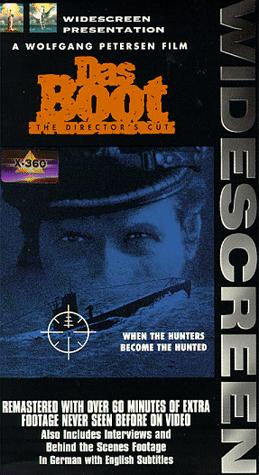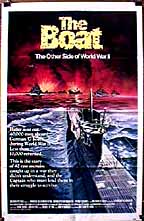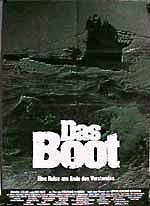 Germany, 149 min, 35mm color in 1.66 : 1 aspect ratio, Dolby Stereo sound, released in West Germany Sept. 17, 1981; released in U.S. 1982 by Columbia with English subtitles; released in 1985 as 5-hour television miniseries; Director's Cut of 210 mins. released on laserdisc Dec. 11, 1997 and on DVD 1998.
Germany, 149 min, 35mm color in 1.66 : 1 aspect ratio, Dolby Stereo sound, released in West Germany Sept. 17, 1981; released in U.S. 1982 by Columbia with English subtitles; released in 1985 as 5-hour television miniseries; Director's Cut of 210 mins. released on laserdisc Dec. 11, 1997 and on DVD 1998.
Directed by Wolfgang Petersen
Written by Wolfgang Petersen,based on the 1973 novel by Lothar G. Buchheim
Produced by Gunter Rohrbach, Ortwin Freyermuth (director's cut)
Original music by Klaus Doldinger
Cinematography by Jost Vacano
Film Editing by Hannes Nikel
Production Design by Gotz Weidner, Rolf Zehetbauer
Art Direction by Walter E. Richarz, Philipp von Seil
Costume Design by Monika Bauert
Casting by Willy Schlenker
Sound by Peter Bond
Special Effects by Karl Baumgartner
 Wolfgang Peterson began filming July 1980 for Bavaria Studios in Munich, and completed filming July 9, 1981. Cinematographer Jost Vacano used a hand-held Arriflex camera for tight interiors, with special gyroscope mount. "In 1981, DAS BOOT was the most expansive and expensive German film ever made. At a cost of about 30 million Deutsche Marks (about $40 million US in today's dollars), a 250-man crew worked for two years and exposed more than a million feet of film before the epic was completed. The film was based on the haunting memoirs of war correspondent Lothar-Gunther Buchheim, who wrote first-hand about the previously unknown lives of the young men who lived together in the cramped, metal tubes of U-boats, hoping against hope to survive." (quote from the Twin Bros web site). The film was based on the real German sub U-96, and the actual captain Heinrich Lehmann-Willenbrock visited set with Buchheim who had been a young correspondent on one of the sub's patrols. This was the 7th patrol that departed St. Nazaire Oct 27, 1941, and returned Dec 6, 1941 after a near-collision with the U-572 during a storm, refueling at Vigo in Spain, surviving an attack by a British Swordfish aircraft from Gibraltar. Buchheim's book was published in Germany in 1973 and was hugely popular. Peterson read it and wanted to make the film; Bavaria studios went to Hollywood to get help, John Sturgis came to Munich and worked for a year, started building the full-scale sub model, brought in Robert Redford to play the captain, but Buchheim opposed Redford and moving the time period to later to introduce Americans. A second Hollywood group tried, with director Don Siegel and Paul Newman as the captain, and this group also failed. Then the German producer Gunter Rohrbach became head of Bavaria studios and took on the project with director Peterson to do the film entirely in German, with Jurgen as the Captain. This film was one of the first to portray the Nazi era without the "Big Guilt thing" typically portrayed in German WWII films; instead, men were human realistic characters. There was much criticism of the film when it premiered in Munich, but it was praised by submariners who saw film in Munich. The only significancgt departure from the book is the ending; in the film the Captain and crew all die.
Wolfgang Peterson began filming July 1980 for Bavaria Studios in Munich, and completed filming July 9, 1981. Cinematographer Jost Vacano used a hand-held Arriflex camera for tight interiors, with special gyroscope mount. "In 1981, DAS BOOT was the most expansive and expensive German film ever made. At a cost of about 30 million Deutsche Marks (about $40 million US in today's dollars), a 250-man crew worked for two years and exposed more than a million feet of film before the epic was completed. The film was based on the haunting memoirs of war correspondent Lothar-Gunther Buchheim, who wrote first-hand about the previously unknown lives of the young men who lived together in the cramped, metal tubes of U-boats, hoping against hope to survive." (quote from the Twin Bros web site). The film was based on the real German sub U-96, and the actual captain Heinrich Lehmann-Willenbrock visited set with Buchheim who had been a young correspondent on one of the sub's patrols. This was the 7th patrol that departed St. Nazaire Oct 27, 1941, and returned Dec 6, 1941 after a near-collision with the U-572 during a storm, refueling at Vigo in Spain, surviving an attack by a British Swordfish aircraft from Gibraltar. Buchheim's book was published in Germany in 1973 and was hugely popular. Peterson read it and wanted to make the film; Bavaria studios went to Hollywood to get help, John Sturgis came to Munich and worked for a year, started building the full-scale sub model, brought in Robert Redford to play the captain, but Buchheim opposed Redford and moving the time period to later to introduce Americans. A second Hollywood group tried, with director Don Siegel and Paul Newman as the captain, and this group also failed. Then the German producer Gunter Rohrbach became head of Bavaria studios and took on the project with director Peterson to do the film entirely in German, with Jurgen as the Captain. This film was one of the first to portray the Nazi era without the "Big Guilt thing" typically portrayed in German WWII films; instead, men were human realistic characters. There was much criticism of the film when it premiered in Munich, but it was praised by submariners who saw film in Munich. The only significancgt departure from the book is the ending; in the film the Captain and crew all die.
 "La Rochelle, France. Autumn, 1941. Germany's vaunted U-boat fleet, with which Hitler hoped to blockade and starve out Britain, is beginning to suffer its first major setbacks. British freighters are now sailing the Atlantic with stronger and more effective destroyer escorts, inflicting heavy losses on the U-boats. Nevertheless, the German High Command orders more and more U-boats, with even younger crews, into battle from their ports in occupied France. The battle for the control of the Atlantic is turning against the Germans."
"La Rochelle, France. Autumn, 1941. Germany's vaunted U-boat fleet, with which Hitler hoped to blockade and starve out Britain, is beginning to suffer its first major setbacks. British freighters are now sailing the Atlantic with stronger and more effective destroyer escorts, inflicting heavy losses on the U-boats. Nevertheless, the German High Command orders more and more U-boats, with even younger crews, into battle from their ports in occupied France. The battle for the control of the Atlantic is turning against the Germans."
"40,000 German sailors served on U-boats during World War II."
30,000 never returned."
Chapter 2 - bar scene (German actor Klaus Wennemann was really drunk) - fight scene at end of the chapter was done with one long continuous shot starting with girl dancing and leading to brawl -Jost Vacano used handheld camera (did not use steadicam although the steadicam technology was available in 1981)
Chapter 4 - crew boards the sub in the La Rochelle pens - the film used only one sub that was built in 3 pieces in Munich and transported to La Rochelle - was empty shell used for exteriors only - the interiors were filmed on another set - this full-size sub was destroyed by storm during filming and pieced back together for end scenes of film. This one sub was filmed twice in the pan with hidden cut. The view from back of sub was done on the last day of filming, June 9, 1981 - filmed in real sub pens at La Rochelle with 6-meter concrete walls (same sub borrowd by Spielberg for Raiders Lost Ark being filmed at same time)
Chapter 5 - 15:00 - sub departs from the La Rochelle pens - huge effort to get all modern ships removed for exterior harbor shots - fullscale model and smaller models still on display for tours at Bavaria studios - many scenes done with 1/6 scale model (ideal size), or 11-meters, overcranked at 55 fps to make it appear heavy - also had smaller models for tank in Munich - orig subs could cruise underwater only 10-12 hours
Chapter 6 at 16:00 - inside the sub - details of interior copied from only complete German sub left in world, at Chicago Museum - walls fixed, not removed for camera - small haze added to interior scenes and walls sprayed to make it look wet - German subs on war cruise had crew of 48 for 9-week voyage - film shot in real time continuity, and men's beards grew naturally over 10 months - Peterson asked all actors to stay our of the sun to give paste look to skin
Chapter 17 - 50:00 - storm sequence as sub rises to surface - some long shots of boat on surface done with 11-meter model with small human model figures that could be moved
Chapter 18 - 51:00 - binocular and periscope views shot in tank only 5 meters deep, destroyer is a model - sub dives
Chapter 21 - 59:00 - depth charge attack - whole set on gimbel and really shook, was scary for actors and crew - explosions were small, done with models, and effect enhanced with sound
Chapter 25 - storm scene used gimbel to tilt boat 45 degrees
Chapter 27 - special split-focus lens used to keep foreground and background scenes in focus of interior desk shot
Chapter 28 - Klaus Wennemann as engineer, looking nostagically at family snapshots
Chapter 29 - close encounter of 2 subs narrowly missed each other (foreground action on stage wih front projection of 2nd sub in backround) - model figures used for waving - event really happened because entire film is based on real events and real characters
1:35 - Chapter 32 - famous running scene down center of entire sub interior was a hand-held shot - Jost Vacano held Arriflex on his belly with special gimbel connected with wire held by assistant running behind him for focus and ran through the boat, needed 16 tries
1:39 - Chapter 32 - depth charges explode, then silence, then ping of the asdic, captain says "Quiet boys." At 1:43 suspense grows as the sound of the destroyer gets louder, explosions, boat shakes, fires, then silence at end of side 1:44.
Chapter 2 - big scene where engineer Johan loses it and Capt goes and gets a gun (controversial - would a sub captain have really done this?)
Chapter 2 at 10:30 - 2nd attack - only time sub wall removed and camera on gimbel does the shaking, rather than whole set shaking, to get closeups of faces to create dream-like state
Chapter 5 - sub surfaces at night - all come out in one long shot without a cut, view the destruction of their work - burning tanker was a 3-meter model - front projection with actors on stage, fire done by Karl Baumgarten - sub pulls away with haunting shot of Capt's face bathed in red light of fires
Chapter 6 - powerful scene, sit in silence, feel bad because unable to pickup the survivors
Chapter 7 - 24:00 - message - decide to go home (right to left) - turning point of the film - decoding machine (Allies captured such a machine early in the war from a sub) - Captain opens top secret envelope - crew playing cards using real WWII slang referring to women - Captain announces new route through Gibraltar - almost suicide for a sub in such shallow waters of the Med. Sea - to refuel and get new supply of 16 torpedoes in Spain, sneak in Rigel (or Vigar) harbor, get supplies from German ships, sneak back out.
Chapter 10 - night harbor scene done with huge harbor model with big exterior water tank outside and miniatures (all ships were models)
Chapter 11 - bright lights of German supply ship, with well-known German actor Gunther Weiderman as the well-dressed German Captain who shakes the hands of the sub crew
Chapter 12 - Naval Attache arrived, gave message to Captain
Chapter 12 - 40:22 - return to sub, bananas and lettuce, prepare to go through Gibraltar, look at map, Captain came up with a plan
Chapter 13 - map of Gibraltar
Chapter 14 - night shot of big boat (done at a lake in Bavaria), taught to hold binoculars correctly, balanced on hands; binocular shots done with models in tank and fog, humorous painting above door
Chapter 15 - attack by airplane (model), prepare to abandon ship, rockets fly as sub burns, begin to descend but rudder stuck and cannot level the boat,
Chapter 16 - 53:00 rivets pop, meter reads max 260, collapsing metal sounds, then boat hits bottom
Chapter 17 - (54:39 hard to see prop girl face with blond hair in lower left under arm)
Chapter 18 - water leaking and spraying as crew desperately tries to repair the boat but it continues to fall apart (never see kitchen in the film, although in the book the Captain makes potato pancakes for the crew); Klaus Wennemann as the Chief Engineer tries many things to save the boat, talks to Captain, whole crew works together
Chapter 20 - Captain's beard longer (has been shooting film 6-10 months) very little makeup except makeup used for cut lips - Buchheim published book comparing real crew with cast and they look very similar
Chapter 22 - 1:14:00 - scene of closeup of correspondent and engineer and Captain, only scene shot with regular studio camera rather than handheld camera;
Chapter 24 - engineer recites Nazi propaganda that he believed in
Chapter 25 - took out wall for wide shot of whole crew in red light watching gauge as sub begins to surface - triumphant music
Chapter 26 - sub breaks through surface and says "up periscope" (this scene was only one used in the original German trailer)
Chapter 27 - great shot of deisel engine coming to life, shaking, engineer shouts with joy; sub on surface cuts through water heading for home
Chapter 28 - daylight view of 11-meter model; returning to big finale as sub returns to La Rochelle, singing Tiperary song
Chapter 29 - La Rochelle harbor return - actual full-size sub (had been damaged and patched together with wood and fabric); most of the extras were French, many who had lived through the war
Chapter 30 - air attack - real planes - $2m cost for explosives used in the film (1m deutschmarks) for special effects supervised by "Charlie Boom-Boom" - at 1:33 huge bomb hits sub pen and almost broke through, debris falls from roof - shots of dead crew done in Munich - 1:34 sub sinks; mechanism used to lower boat into water, then bring it back up to film again - Captain falls over dead. End credits begin at 1:35.